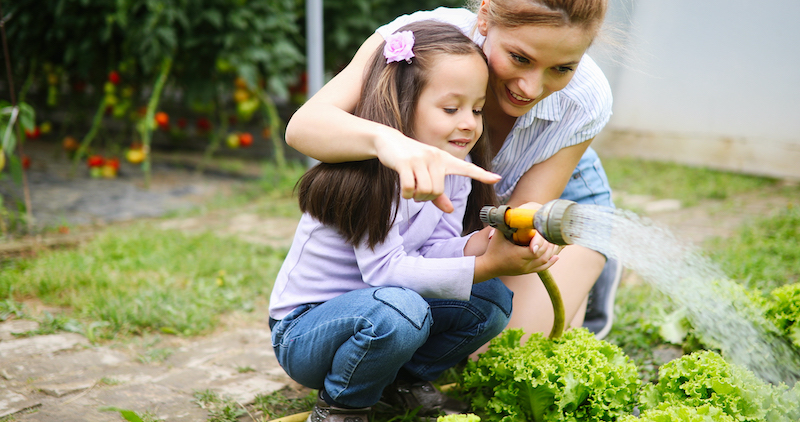Summer is here and so is the hot, dry weather. Now is the time to make a plan for watering your garden that will save you time and money as well as water your plants in the healthiest way possible. Here are our top five tips for effectively and efficiently watering a vegetable garden to keep plants healthy.
5 Tips for Watering a Vegetable Garden
1. Don’t water the leaves
Plants do not need water on their leaves. Be sure to aim the water directly at the soil. Watering the foliage of the plant can foster fungal diseases that can weaken your plant and invite pests to attack it. During the heat of the day, rapid evaporation of water on the plant’s leaves can leave burn marks which also weaken the plant.
2. Check the soil
To determine if you need to water your plants, check to see if the soil is wet 3-6 inches below the surface. The soil surface tends to dry out quickly and is not a good determining factor for the overall soil moisture level.
 3. Water deeply and less often
3. Water deeply and less often
Instead of lightly watering your plants every day, soak the soil around your crops 3-5 times a week. Watering deeply will encourage the roots to grow and will make your plants stronger.
4. Water in the morning
Water your plants early in the morning or in the evening. Watering your plants in the heat of the day will result in more water lost to evaporation. Watering your plants late at night will increase warmth and humidity around your plants which may promote fungal diseases.
5. Don’t overwater
Overwatering can be just as detrimental to your plants as under-watering. Check to see if your garden beds and containers have good drainage so that water isn’t pooling at the bottom. This is especially problematic with clay soils.
At TAFB’s Learning Garden, we demonstrate several different options for watering your garden.
Buried Irrigation
We have buried irrigation that is controlled by timers around the perimeter of the property. This type of irrigation is great for the perennial trees and vines we have on our fence line, but is not a realistic option for most home gardeners.
Soaker Hoses
In other areas of the garden, we have soaker hoses installed that are also connected to the timer system. These soaker hoses drip water out of the many tiny holes in the hose and are a great option for densely planted areas.
Drip Irrigation
This gravity fed irrigation system uses basic materials and tools to create a very simple watering system. Each time we want to water the plants along these systems, we just fill the feeder bucket up with water and the water is distributed evenly out of the drip tape. This system dispenses water where the plants need it and reduces the amount of water lost to evaporation. For detailed information on drip bucket irrigation systems with information from local civil engineer, Jon Fripp, check out this link.
Ollas
Our ollas are homemade out of terra cotta pots and saucers. These buried water reservoirs can be filled up whenever needed and the water will slowly seep out of the pores in the clay. This methods allows for deep watering and consistent moisture. Learn more about ollas.
Hand Watering
The most common watering method we use at the TAFB Learning Garden is hand watering with hoses and watering wands. This method is effective and does the job without having to install any irrigation. The downside is that it’s not very efficient and can be very time consuming if you have a large garden.
Providing adequate water for your edible plants throughout the hot, Texas summer is critical. Proper watering will help keep your plants strong and healthy to avoid devastation from pests or diseases.
To learn more about hands-on volunteer opportunities in the TAFB Learning Garden, visit our Volunteer page. For information about our gardening workshops and events, visit https://tafb.org/staging/community-garden/.
By Becca Knutson
TAFB Community Garden Coordinator


